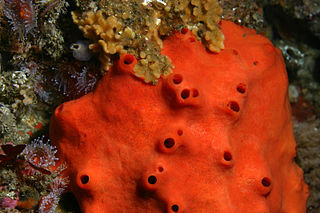
Hexactinellid sponges are sponges with a skeleton made of four- and/or six-pointed siliceous spicules, often referred to as glass sponges. They are usually classified along with other sponges in the phylum Porifera, but some researchers consider them sufficiently distinct to deserve their own phylum, Symplasma. Some experts believe glass sponges are the longest-lived animals on earth; these scientists tentatively estimate a maximum age of up to 15,000 years.

Spicules are structural elements found in most sponges. The meshing of many spicules serves as the sponge's skeleton and thus it provides structural support and potentially defense against predators.

The orange wall sponge is a species of sea sponge belonging to the order Trachycladida. It is found in the south Atlantic and Indo-Pacific oceans. Around the South African coast, it is known from the Cape Peninsula to Cape Agulhas.

Myxilla incrustans is a species of demosponge. It is an encrusting species and is usually yellow.
Homaxinella balfourensis is a species of sea sponge in the family Suberitidae. It is found in the seas around Antarctica and can grow in two forms, either branching out in one plane like a fan or forming an upright club-like structure.

Reticulosa is an extinct order of sea sponges in the class Hexactinellida and the subclass Amphidiscophora. Reticulosans were diverse in shape and size, similar to their modern relatives, the amphidiscosidans. Some were smooth and attached to a surface at a flat point, others were polyhedral or ornamented with nodes, many were covered in bristles, and a few were even suspended above the seabed by a rope-like anchor of braided glass spicules.

Amphidiscosida is an order of hexactinellids. The Amphidiscosida are commonly regarded as the only living sponges in the subclass Amphidiscophora.
Claviscopulia is a genus of glass sponge in the family Farreidae.

Bolosoma is a genus of pedunculated siliceous sponges belonging to the family Euplectellidae. This genus lives in deep-sea environments and provides a habitat for a plethora of other benthic species, giving Bolosoma an incredibly important ecological role in the ecosystems it is a part of.

Acarnidae is a family of sponges belonging to the order Poecilosclerida. It has a global distribution, although several genera occur primarily in colder temperate waters, and several have very restricted ranges. It is estimated that there are several hundred species.

Coelosphaeridae is a family of sponges belonging to the order Poecilosclerida. Species are found across the globe.
Hamacantha esperoides is a species of demosponge. It is commonly known as the fibrous sponge. It occurs off the southern and western coasts of South Africa, off the coast of Namibia, and off the southeast coast of South America.
Inflatella belli, or the gooseberry sponge, is a species of demosponge that appears to be restricted to the southern hemisphere, where it is widespread. It occurs from the coast of Namibia and the Indo-pacific, down to the Subantarctic and Antarctic regions.
Polymastia bouryesnaultae, the knobbly sponge, is a small and cryptic species of demosponge from South Africa and Namibia.
Suberites dandelenae, the amorphous solid sponge, is a species of deep-sea demosponge from South Africa and Namibia.
Penares sphaera, the crater sponge, is a deep sea demosponge from southern Africa.
Tetilla capillosa, the furry sponge, is a species of demosponge from southern Africa.
Tetilla casula, the volcano sponge, is a species of demosponge from the south coast of South Africa.

Rosella is a genus of glass sponges in the family Rossellidae. It is found in the Antarctic and sub-Antarctic regions.
Rossella antarctica is a relatively small species of glass sponge. It is widely distributed in the southern hemisphere, particularly in the Antarctic and sub-Antarctic regions.









